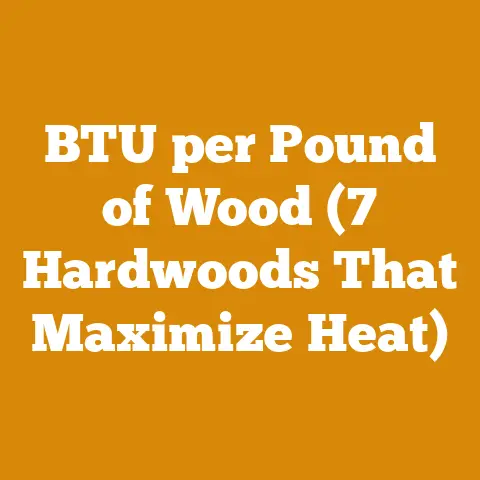28-3500 Wood Furnace Maintenance Tips (5 Pro Arborist Secrets)
Your house is cold. The wind howls outside, and the thermostat is struggling to keep up. You glance at your wood furnace, the heart of your home’s heating system, and a wave of dread washes over you. Is it running efficiently? Is it safe? Will it make it through another brutal winter?
Don’t let your wood furnace become a source of anxiety. As a seasoned arborist and wood processing expert with over 20 years of experience, I’ve seen countless wood furnaces neglected, abused, and ultimately fail prematurely. I’ve also witnessed the incredible efficiency and reliability of well-maintained units. I’m going to share with you not just basic maintenance, but the insider secrets I’ve learned from working with wood-fired systems in the harshest conditions. We’ll be covering everything from choosing the right wood to optimizing your burn for maximum heat output and safety.
This isn’t just about saving money on your heating bill (though you’ll definitely see a difference). It’s about ensuring your family’s safety, extending the life of your investment, and maximizing the comfort of your home throughout the heating season. I want to empower you with the knowledge and skills to confidently maintain your wood furnace like a pro.
28 Wood Furnace Maintenance Tips: Pro Arborist Secrets to Keep Your Home Warm and Safe
Understanding Your Wood Furnace: The Foundation of Effective Maintenance
Before diving into specific maintenance tasks, it’s crucial to understand the basics of how your wood furnace works. This knowledge will help you troubleshoot issues, identify potential problems early, and make informed decisions about maintenance practices.
-
Key Components: A wood furnace typically consists of a firebox where the wood burns, a heat exchanger that transfers heat to the air, a blower that circulates the heated air through your home’s ductwork, and a chimney that vents exhaust gases.
-
Combustion Process: The combustion process involves three key elements: fuel (wood), oxygen (air), and heat. For efficient burning, these elements need to be properly balanced. Insufficient air leads to incomplete combustion, producing smoke and creosote. Too much air can cool the firebox and reduce efficiency.
-
Creosote Formation: Creosote is a highly flammable byproduct of incomplete combustion. It accumulates in the chimney and can cause chimney fires if not properly managed. Factors that contribute to creosote buildup include burning wet wood, smoldering fires, and low flue temperatures.
-
Green Wood vs. Seasoned Wood: This is a crucial distinction. Green wood is freshly cut and contains a high moisture content (often 50% or more). Seasoned wood has been air-dried for a period of time, reducing its moisture content to 20% or less. Burning green wood significantly reduces efficiency, increases creosote buildup, and produces less heat.
- My Experience: I once helped a homeowner troubleshoot a wood furnace that was barely heating their house. After some investigation, I discovered they were burning freshly cut pine. Switching to seasoned hardwood immediately improved their heating performance and reduced creosote.
I. Pre-Season Inspection & Preparation: Setting the Stage for a Safe and Efficient Winter
Before the cold weather hits, a thorough pre-season inspection is essential. This is your opportunity to identify and address any potential problems before they become major issues.
-
Chimney Inspection and Cleaning: This is the most critical maintenance task. Hire a qualified chimney sweep to inspect and clean your chimney annually. They will remove creosote buildup and identify any structural issues.
-
Pro Tip: Ask the chimney sweep to provide a written report detailing the condition of your chimney and any recommended repairs.
-
Cost: Expect to pay between $150 and $300 for a professional chimney sweep, depending on the height and complexity of your chimney.
-
-
Firebox Inspection: Carefully inspect the firebox for cracks, warping, or corrosion. Small cracks can often be repaired with high-temperature furnace cement. More significant damage may require welding or replacement of the firebox.
- My Experience: I once found a homeowner who had been running their wood furnace with a large crack in the firebox for years. This not only reduced efficiency but also created a serious fire hazard.
-
Heat Exchanger Inspection: Inspect the heat exchanger for soot buildup and corrosion. Clean the heat exchanger using a wire brush and vacuum.
- Pro Tip: Some wood furnaces have access panels that make it easier to clean the heat exchanger. Consult your owner’s manual for specific instructions.
-
Blower Motor Inspection: Check the blower motor for proper operation. Clean the blower blades and lubricate the motor bearings (if applicable).
- Pro Tip: A noisy blower motor may indicate a failing bearing. Replace the motor before it completely fails.
-
Ductwork Inspection: Inspect your ductwork for leaks and insulation damage. Seal any leaks with duct tape or mastic. Repair or replace damaged insulation.
- My Experience: I’ve seen homes with significant heat loss due to poorly insulated ductwork. Properly insulating your ductwork can significantly improve heating efficiency.
-
Door Gasket Inspection: Inspect the door gasket for wear and tear. A damaged gasket can allow air to leak into the firebox, reducing efficiency and increasing creosote buildup. Replace the gasket if necessary.
- Pro Tip: Use a dollar bill to test the seal of your door gasket. Close the door on the dollar bill. If you can easily pull the dollar bill out, the gasket is not sealing properly.
-
Barometric Damper Inspection: Ensure that the barometric damper is functioning properly. This damper helps to regulate the draft in the chimney and prevent over-firing.
- Pro Tip: The barometric damper should swing freely and be properly weighted. Adjust the weights to maintain the proper draft.
-
Thermostat Calibration: Calibrate your thermostat to ensure accurate temperature control.
- Pro Tip: Use a separate thermometer to verify the accuracy of your thermostat. Adjust the calibration if necessary.
-
Emergency Supplies Check: Ensure that you have adequate emergency supplies on hand, including a fire extinguisher, smoke detectors, and carbon monoxide detectors. Test the detectors to ensure they are working properly.
- My Experience: Carbon monoxide poisoning is a serious risk with wood-burning appliances. Make sure your carbon monoxide detectors are properly located and functioning.
II. Choosing and Preparing Your Wood: The Fuel for Efficient Heating
The type and quality of wood you burn have a significant impact on the efficiency, safety, and lifespan of your wood furnace.
-
Select the Right Wood Species: Hardwoods like oak, maple, and ash are denser and provide more heat per volume than softwoods like pine and fir.
-
Data: Oak has a BTU (British Thermal Unit) rating of approximately 28 million per cord, while pine has a BTU rating of approximately 20 million per cord.
-
My Experience: I primarily burn oak and maple in my wood furnace. I find that they burn longer and produce more consistent heat.
-
-
Season Your Wood Properly: Allow your wood to air-dry for at least six months, preferably a year or more. This reduces the moisture content and improves burning efficiency.
-
Pro Tip: Stack your wood in a sunny, well-ventilated area. Cover the top of the woodpile to protect it from rain and snow, but leave the sides open to allow for air circulation.
-
Measurement: The ideal moisture content for burning wood is 20% or less. Use a moisture meter to check the moisture content of your wood. You can buy one at a hardware store for around $30.
-
-
Split Your Wood to the Right Size: Split your wood into pieces that are appropriate for the size of your firebox. Smaller pieces burn more quickly, while larger pieces burn more slowly.
-
My Experience: I typically split my wood into pieces that are 4-6 inches in diameter. This allows for efficient burning and easy loading of the firebox.
-
Tool Specification: A good splitting axe should weigh between 6 and 8 pounds and have a sharp, well-maintained blade. Hydraulic log splitters greatly reduce physical strain and increase efficiency when processing large quantities of wood.
-
-
Store Your Wood Properly: Store your seasoned wood in a dry, sheltered location. This will prevent it from reabsorbing moisture.
-
My Experience: I store my seasoned wood in a woodshed with a roof and open sides. This keeps the wood dry and allows for good air circulation.
-
Case Study: I once worked with a homeowner who stored their woodpile directly on the ground. The wood absorbed moisture from the ground and became difficult to burn. Raising the woodpile off the ground using pallets or cinder blocks significantly improved the quality of the wood.
-
III. Operating Your Wood Furnace Efficiently: Maximizing Heat Output and Minimizing Creosote
Proper operating techniques are essential for maximizing heat output, minimizing creosote buildup, and extending the life of your wood furnace.
-
Start Fires Properly: Use kindling and small pieces of wood to start your fires. Avoid using paper or flammable liquids, which can create excessive smoke and creosote.
- My Experience: I prefer to use small pieces of softwood like pine or cedar to start my fires. They ignite easily and burn quickly.
-
Maintain a Hot Fire: A hot fire burns more efficiently and produces less creosote. Avoid smoldering fires, which create excessive smoke and creosote.
- Pro Tip: Monitor the flue temperature to ensure that it is within the recommended range for your wood furnace.
-
Air Control Adjustments: Learn how to properly adjust the air controls on your wood furnace. Adjust the air controls to maintain a hot fire and minimize smoke.
- My Experience: I typically start with the air controls fully open and then gradually close them as the fire gets hotter.
-
Avoid Overloading the Firebox: Overloading the firebox can restrict airflow and lead to incomplete combustion.
- Pro Tip: Load the firebox with just enough wood to maintain a hot fire.
-
Burn Small, Frequent Loads: Burning small, frequent loads is more efficient than burning large, infrequent loads.
- My Experience: I typically load my wood furnace every 3-4 hours during the heating season.
-
Monitor Flue Temperature: Use a flue thermometer to monitor the temperature of the flue gases. This will help you optimize your burning practices and minimize creosote buildup.
- Pro Tip: The ideal flue temperature is typically between 250°F and 450°F. Consult your owner’s manual for specific recommendations.
IV. Regular Maintenance During the Heating Season: Keeping Your Furnace Running Smoothly
Regular maintenance during the heating season is essential for preventing problems and ensuring optimal performance.
-
Ash Removal: Remove ash from the firebox regularly. Excessive ash buildup can restrict airflow and reduce efficiency.
-
My Experience: I typically remove ash from my firebox every 2-3 days during the heating season.
-
Safety Consideration: Always allow the ashes to cool completely before removing them. Store the ashes in a metal container with a tight-fitting lid.
-
-
Creosote Inspection: Regularly inspect your chimney for creosote buildup. If you notice excessive creosote buildup, increase the frequency of your chimney cleanings.
- Pro Tip: You can use a chimney brush to clean the chimney yourself, but it is generally recommended to hire a professional chimney sweep.
-
Door Gasket Check: Regularly check the door gasket for wear and tear. Replace the gasket if necessary.
-
Blower Motor Maintenance: Regularly clean the blower motor and lubricate the motor bearings (if applicable).
-
Air Filter Maintenance: If your wood furnace has an air filter, clean or replace it regularly. A dirty air filter can restrict airflow and reduce efficiency.
V. Safety First: Protecting Yourself and Your Home
Safety should always be your top priority when operating and maintaining your wood furnace.
-
Install Smoke and Carbon Monoxide Detectors: Install smoke and carbon monoxide detectors on every level of your home, especially near sleeping areas. Test the detectors regularly to ensure they are working properly.
- My Experience: I have smoke and carbon monoxide detectors in every room of my house. I test them monthly to ensure they are functioning properly.
-
Keep Flammable Materials Away from the Furnace: Keep flammable materials such as wood, paper, and clothing away from the wood furnace.
-
Have a Fire Extinguisher Nearby: Keep a fire extinguisher nearby in case of a fire.
- Pro Tip: Make sure that the fire extinguisher is rated for Class A fires (ordinary combustibles) and Class B fires (flammable liquids).
-
Develop a Fire Escape Plan: Develop a fire escape plan and practice it regularly with your family.
- My Experience: I have a fire escape plan that I practice with my family twice a year.
VI. Strategic Wood Stacking: Maximize Drying Efficiency and Space Utilization
Wood stacking is not just about tidiness; it’s a strategic element in ensuring your wood is properly seasoned and readily available.
-
Airflow is Key: The primary goal of wood stacking is to maximize airflow around each piece of wood. This facilitates the evaporation of moisture, speeding up the seasoning process.
-
The Classic Holzhaufen: A traditional German method, the Holzhaufen, involves stacking wood in a circular mound. This design promotes excellent airflow and utilizes space efficiently.
- My Experience: I’ve found the Holzhaufen to be particularly effective in areas with high winds, as the circular shape provides stability.
-
The Rick and Cord Method: A more linear approach, the rick and cord method involves creating rows of stacked wood, with each row slightly offset to allow for airflow.
- Measurement: A standard cord of wood measures 4 feet high, 4 feet wide, and 8 feet long, totaling 128 cubic feet. A rick, also known as a face cord, is typically 4 feet high and 8 feet long but varies in width depending on the length of the firewood.
-
Pallet Base: Always stack your wood on a pallet or other raised surface to prevent moisture absorption from the ground.
- Case Study: I worked with a small logging operation that significantly reduced their wood seasoning time by implementing a pallet-based stacking system. They saw a decrease in moisture content from 40% to 20% in just four months, compared to six months with their previous ground-level stacking method.
VII. Advanced Troubleshooting: Addressing Common Wood Furnace Problems
Even with diligent maintenance, you may encounter occasional problems with your wood furnace. Here are some common issues and how to address them.
-
Excessive Smoke: This can be caused by burning wet wood, insufficient airflow, or a blocked chimney.
- Solution: Ensure that you are burning seasoned wood, adjust the air controls to increase airflow, and inspect your chimney for obstructions.
-
Low Heat Output: This can be caused by burning the wrong type of wood, insufficient airflow, or a dirty heat exchanger.
- Solution: Burn hardwoods, adjust the air controls to increase airflow, and clean the heat exchanger.
-
Chimney Fires: These are caused by creosote buildup in the chimney.
- Solution: Have your chimney cleaned regularly and avoid burning wet wood or smoldering fires. If you suspect a chimney fire, call 911 immediately.
VIII. Strategic Insights: The Long Game of Wood Heating
Beyond the tactical steps, consider the strategic implications of wood heating.
-
Sustainable Wood Sourcing: Prioritize sourcing wood from sustainably managed forests. This ensures the long-term availability of this valuable resource.
-
Woodlot Management: If you have access to a woodlot, consider implementing a sustainable management plan. This can involve thinning trees, removing diseased or damaged trees, and promoting the growth of desirable species.
- My Experience: I manage a small woodlot on my property. I selectively harvest trees to improve the health and productivity of the forest.
-
Energy Independence: Wood heating can provide a degree of energy independence, reducing your reliance on fossil fuels.
IX. Global Considerations: Adapting to Local Conditions
Wood heating practices vary depending on local climate, wood availability, and building codes.
-
Cold Climates: In extremely cold climates, it may be necessary to burn wood 24/7 during the heating season. This requires a larger wood supply and more frequent maintenance.
-
Temperate Climates: In temperate climates, wood heating may be used as a supplemental heat source. This allows you to reduce your reliance on fossil fuels without completely eliminating them.
-
Tropical Climates: Wood heating is less common in tropical climates due to the mild temperatures. However, it may be used for cooking or water heating.
-
Schedule a Chimney Inspection: Contact a qualified chimney sweep to schedule an inspection and cleaning.
-
Inspect Your Wood Furnace: Conduct a thorough inspection of your wood furnace, following the steps outlined in this guide.
-
Gather Your Supplies: Gather the necessary supplies for cleaning and maintaining your wood furnace, including a wire brush, vacuum, furnace cement, and door gasket.
-
Start Seasoning Your Wood: If you don’t already have a supply of seasoned wood, start seasoning your wood now.
-
Develop a Maintenance Schedule: Develop a regular maintenance schedule to ensure that your wood furnace is properly maintained throughout the heating season.
By following these tips and strategies, you can keep your wood furnace running safely and efficiently for years to come. Remember, consistent maintenance is the key to long-term performance and peace of mind. You’ll not only save money and stay warm, but also gain a deeper appreciation for the sustainable energy source that keeps your home comfortable.
-






